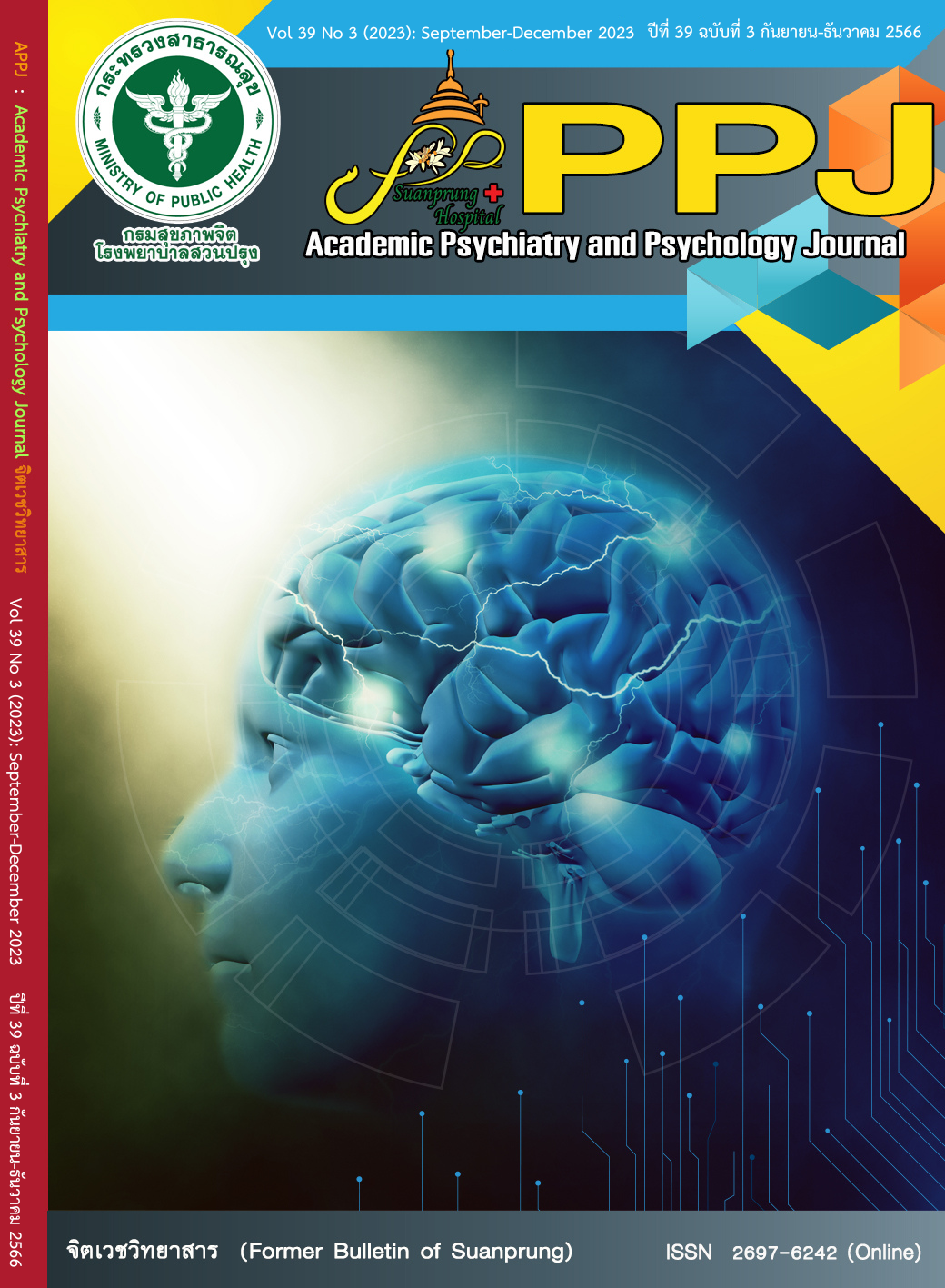ความสัมพันธ์ระหว่างคะแนน Prediction of Alcohol Withdrawal Severity Scale (PAWSS) กับการเกิดกลุ่มอาการถอนสุรารุนแรงในโรงพยาบาลธัญญารักษ์ขอนแก่น
Main Article Content
บทคัดย่อ
วัตถุประสงค์ : ศึกษาความสัมพันธ์ของ PAWSS กลุ่มเสี่ยงสูงกับภาวะถอนสุรารุนแรงในโรงพยาบาลธัญญารักษ์ขอนแก่น
วิธีการ : ทำการศึกษานำร่องแบบภาคตัดขวาง โดยทบทวนเวชระเบียนผู้ป่วยติดสุราตามเกณฑ์ DSM-4 ที่เข้ารับการรักษาในหอผู้ป่วย วันที่ 1 ถึง 30 เมษายน 2566 ผลลัพธ์หลักคือความสัมพันธ์ของคะแนน PAWSS ≥ 4 กับการเกิดกลุ่มอาการถอนสุรารุนแรงซึ่งรายงานด้วยอัตราส่วนออด (odds ratio, OR) และช่วงความเชื่อมั่นร้อยละ 95 (95% confidence interval, 95%CI) กำหนดค่าความแตกต่างอย่างมีนัยสำคัญทางสถิติคือ p < 0.05
ผล : มีผู้เข้าเกณฑ์ 30 ราย เกิดภาวะถอนสุรารุนแรง 12 ราย (ร้อยละ 40) ลักษณะผู้ป่วยทั้ง 2 กลุ่มไม่แตกต่างกัน กลุ่มที่เกิดภาวะถอนสุรารุนแรงมีค่า PAWSS ≥ 4 ร้อยละ 75 เปรียบเทียบกับกลุ่มที่ไม่เกิดภาวะถอนสุรารุนแรงมีค่า PAWSS ≥ 4 ร้อยละ 78 อย่างไรก็ตามไม่พบความสัมพันธ์ของคะแนน PAWSS ≥ 4 กับภาวะถอนสุรารุนแรง (OR, 1.17; 95%CI, 0.21-6.48) ผู้ป่วยกลุ่มถอนสุรารุนแรงมีคะแนน CIWA-Ar สูงกว่า ได้รับยาเบนโซไดอะเซปีนสูงกว่าใน 7 วันแรก ระยะเวลาการหายจากโรคนานกว่าอย่างมีนัยสำคัญ
สรุป : ไม่พบความสัมพันธ์ของคะแนน PAWSS ≥ 4 กับการเกิดภาวะถอนสุรารุนแรง ควรมีการศึกษาเพิ่มเติมเพื่อหาแนวทางการป้องกัน
Article Details

This work is licensed under a Creative Commons Attribution-NonCommercial-NoDerivatives 4.0 International License.
บทความหลังผ่านการปรับแก้จากกองบรรณาธิการแล้ว เป็นลิขสิทธ์ของวารสารจิตเวชวิทยาสาร โรงพยาบาลสวนปรุง กรมสุขภาพจิต กระทรวงสาธารณสุข ห้ามเผยแพร่เพื่อประโยชน์ทางการค้าโดยไม่ได้รับอนุญาต แต่อนุญาตให้เผยแพร่บทความดังกล่าวเพื่อประโยชน์ทางการศึกษาแก่ประชาชนทั่วไป ทั้งนี้กองบรรณาธิการไม่จำเป็นต้องเห็นด้วยกับบทความหรือข้อคิดเห็นใดๆ ที่ปรากฏในวารสารสวนปรุง
References
World Health Organization. Global status report on alcohol and health 2018 [Internet]. Geneva: World Health Organization; 2018 [cited 2023 Mar 27]. 450 p. Available from: https://apps.who.int/iris/handle/10665/274603
The National Statistical Office. National annual survey report 2017 (in Thai) [Internet]. [cited 2023 Mar 27]. Available from: http://www.nso.go.th/sites/2014/Pages/News/2561/N30-08-61-2.aspx
Kattimani S, Bharadwaj B. Clinical management of alcohol withdrawal: A systematic review. Ind Psychiatry J. 2013;22(2):100–8.
Etherington JM. Emergency management of acute alcohol problems. Part 1: Uncomplicated withdrawal. Can Fam Physician. 1996 Nov;42:2186–90.
Victor M, Adams RD. The effect of alcohol on the nervous system. Res Publ - Assoc Res Nerv Ment Dis. 1953;32:526–73.
Victor M, Brausch C. The role of abstinence in the genesis of alcoholic epilepsy. Epilepsia. 1967 Mar;8(1):1–20.
Schuckit MA. Recognition and management of withdrawal delirium (delirium tremens). N Engl J Med. 2014 Nov 27;371(22):2109–13.
Schmidt KJ, Doshi MR, Holzhausen JM, Natavio A, Cadiz M, Winegardner JE. Treatment of Severe Alcohol Withdrawal. Ann Pharmacother. 2016 May;50(5):389–401.
Goodson CM, Clark BJ, Douglas IS. Predictors of severe alcohol withdrawal syndrome: a systematic review and meta-analysis. Alcohol Clin Exp Res. 2014 Oct;38(10):2664–77.
Schuckit MA. Alcohol-use disorders. Lancet Lond Engl. 2009 Feb 7;373(9662):492–501.
Tsuang JW, Irwin MR, Smith TL, Schuckit MA. Characteristics of men with alcoholic hallucinosis. Addict Abingdon Engl. 1994 Jan;89(1):73–8.
Stephane M, Arnaout B, Yoon G. Alcohol withdrawal hallucinations in the general population, an epidemiological study. Psychiatry Res. 2018 Apr;262:129–34.
Hillbom M, Pieninkeroinen I, Leone M. Seizures in alcohol-dependent patients: epidemiology, pathophysiology and management. CNS Drugs. 2003;17(14):1013–30.
Eyer F, Schuster T, Felgenhauer N, Pfab R, Strubel T, Saugel B, et al. Risk assessment of moderate to severe alcohol withdrawal--predictors for seizures and delirium tremens in the course of withdrawal. Alcohol Alcohol Oxf Oxfs. 2011;46(4):427–33.
Wood E, Albarqouni L, Tkachuk S, Green CJ, Ahamad K, Nolan S, et al. Will This Hospitalized Patient Develop Severe Alcohol Withdrawal Syndrome?: The Rational Clinical Examination Systematic Review. JAMA. 2018 Aug 28;320(8):825–33.
Livne O, Feinn R, Knox J, Hartwell EE, Gelernter J, Hasin DS, et al. Alcohol withdrawal in past-year drinkers with unhealthy alcohol use: Prevalence, characteristics, and correlates in a national epidemiologic survey. Alcohol Clin Exp Res. 2022 Mar;46(3):422–33.
Dixit D, Endicott J, Burry L, Ramos L, Yeung SYA, Devabhakthuni S, et al. Management of Acute Alcohol Withdrawal Syndrome in Critically Ill Patients. Pharmacotherapy. 2016 Jul;36(7):797–822.
Maldonado JR, Sher Y, Ashouri JF, Hills-Evans K, Swendsen H, Lolak S, et al. The “Prediction of Alcohol Withdrawal Severity Scale” (PAWSS): systematic literature review and pilot study of a new scale for the prediction of complicated alcohol withdrawal syndrome. Alcohol Fayettev N. 2014 Jun;48(4):375–90.
Maldonado JR, Sher Y, Das S, Hills-Evans K, Frenklach A, Lolak S, et al. Prospective Validation Study of the Prediction of Alcohol Withdrawal Severity Scale (PAWSS) in Medically Ill Inpatients: A New Scale for the Prediction of Complicated Alcohol Withdrawal Syndrome. Alcohol Alcohol. 2015 Sep 1;50(5):509–18.
Bedienungsanleitung ACE DA7100_D_E_F_NL_I_ES.pdf [Internet]. [cited 2023 Oct 13]. Available from: https://www.ace-technik.com/documents/products/Media/Bedienungsanleitung%20ACE%20DA7100_D_E_F_NL_I_ES.pdf?ver=1662972992
